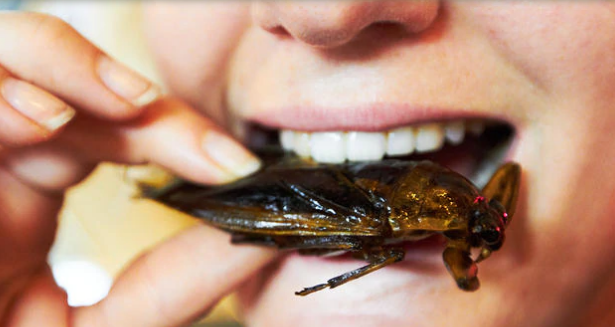All I wanted was a simple wrap for my almond butter, banana and marmalade (don’t ask, it is my version of winter comfort food). I buy wraps on a fairly regular basis and am used to the variations on the theme. All made from some sort of wheat flour – or gluten free, all claiming to be uncrackable (ha, they have not been tested with my butter paneer and salad) and most claiming to have an added flavour which will make our gustatory experience divine.
Then I spied the outlier, the deal breaker, the new wrap on the block – the Cricket Flour Wrap. Cricket flour, really? It is a thing? Not only is it a thing but a little internet search brings up the New Zealand site Eat Crawlers who make Cricket Flour and say,
“Cricket Flour is a unique Super-Food that enables you to add Protein, Calcium & B12 into your diet like never before! It’s Grain Free, Dairy Free and it’s Paleo friendly too! Cricket flour is 100% natural, no preservatives, artificial colours or flavours have been added.”
Seemingly there are such things as cricket farms. Eat Crawlers source their crickets from such a farm in Thailand.
There are recipes too using the flour from various insects. Thrillist offers 8 insect recipes it dares you to eat.
So why are we being encouraged to try out the creepy crawlies for dinner.
The UN’s Food and Agriculture Organisation 2015 account on edible insects says,
“Trends towards 2050 predict a steady population increase to 9 billion people, forcing an increased food/feed output from available agro-ecosystems resulting in an even greater pressure on the environment. Scarcities of agricultural land, water, forest, fishery and biodiversity resources, as well as nutrients and non-renewable
energy are foreseen.
Edible insects contain high quality protein, vitamins and amino acids for humans. Insects have a high food conversion rate, e.g. crickets need six times less feed than cattle, four times less than sheep, and twice less than pigs and broiler chickens to produce the same amount of protein. Besides, they emit less greenhouse gases and ammonia than conventional livestock. Insects can be grown on organic waste. Therefore, insects are a potential source for conventional production (mini-livestock) of protein, either for direct human consumption, or indirectly in recomposed foods (with extracted protein from insects); and as a protein source into feedstock mixtures.”
The FAO says that at least 527 different insects are eaten across 36 countries in Africa, while insects are also eaten in 29 countries in Asia and 23 in the Americas.
Agriculture and Food Security presents evidence for ongoing discussions about changing laws, for instance in the EU and the US to allow the use of insects for, in the first instance, animal feed. Although some do caution that too little is known about the possibility of insect pathogens (see 3 below),
“Veterinary science in insect farming is in its infancy. Very little is known about insect diseases which may emerge at large-scale rearing: biological and genetic characterisation, phylogeny, host range, transmission, persistence, epidemic potential and safety for animals including humans”
AFS does acknowledge “Western consumers are hard to convince to eat insects, even when aware of environmental, nutritional and food safety benefits and their excellent taste.” They conclude that “Emotional and psychological impediments to acceptance have to be addressed,”
More recent research suggests the possibility of attitude change. According to a recent article people who frequently consume sushi are more open to introducing edible insects into their diets. The research, published this year online in the journal Food Quality and Preference, involved interviews with people from two countries: one group of 275 participants were from the United States and the other group of 201 individuals hailed from India. In both countries, the frequency of sushi consumption – food that was commonly met with disgust when it was first introduced – was a significant and substantial predictor of insect acceptance. The results showed that 82 per cent of American participants were willing to eat insects, while 43 per cent ate sushi often.
The study concludes that, “the more open you are to ‘exotic’ foods, the more willing you’ll be to taste-test a grasshopper, or an ant, or even a spider.”
I think it is fairly certain that you can expect to see an increasing range of insect based products coming to an outlet near you as the cricket, grasshoppers, mealworm, beetles and ants are taken up as a healthy, environmental virtuous protein source. The problem I have with this is that I have now seen two sites which claim that cricket flour is suitable for vegetarians and vegans. I do not think so.
Click over to Bugvivant for a recipe for Cricket Snaps using the aforementioned Cricket Flour.
Sources:
- 1. Eat Crawlers
- 2.Thrillist
- 3. Food and Agriculture Organisation, United Nations, Edible Insects for Food and Feed, A Solution for Food and Feed Security, 2015, updated May 2019. http://www.fao.org/edible-insects/en/
- 4. Anton van Huis, Edible insects contributing to food security? In Agriculture & Food Security, Vol 4, Article number: 20 (2015).
- 5. Eilenberg J, Vlak JM, Nielsen-LeRoux C, Cappellozza S, Jensen AB. Diseases in insects produced for food and feed. Journal of Insects Food Feed. 2015; 1(2): 87–102.
- 6. B. Ruby, Matthew & Rozin, Paul, 2019, Disgust, sushi consumption, and other predictors of acceptance of insects as food by Americans and Indians, in Food Quality and Preference, vol 74, 2019/06/01
- 7. Bugivant

An addendum: This product contains ‘lupin flour’. Just sayin….














